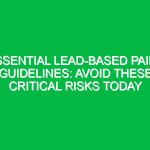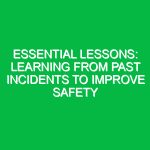“`html
Must-Know Lead Paint Dangers and Safety Guidelines to Protect Your Health
Introduction
Good morning team,
Today, we’re diving into an essential topic that affects not only our work Environment but our health as well. We’ll be discussing the must-know lead paint dangers and safety guidelines to protect your health. Understanding these risks is crucial for maintaining a safe workplace, especially if you work in construction, renovation, or any environment where lead paint may be present.
Lead exposure can have serious health implications, and it’s vital for us to recognize the signs and take proactive measures. Let’s explore why this topic is critical for our safety and how we can protect ourselves and each other.
Understanding Lead Paint Dangers
Lead paint, once a common choice for homes and buildings, has been banned in many countries due to its toxic Effects. Lead exposure can occur through inhalation of lead dust, ingestion of lead particles, or through skin contact. Understanding the dangers of lead paint is essential for anyone working in affected environments.
Many people mistakenly believe that as long as they do not see peeling paint, they are safe from lead exposure. However, lead dust can still be present in homes built before 1978, when lead-based paint was banned in the U.S. It’s not just the obvious Hazards we need to worry about, but also the hidden dangers that can impact our health.
Key Hazards, Risks, and Safety Considerations
Lead exposure can result in a range of health issues, including:
- Neurological Effects: Lead exposure can cause cognitive impairments and developmental delays in children.
- Physical Health Issues: Adults may experience high blood pressure, kidney damage, and reproductive problems.
- Behavioral Issues: Lead poisoning is linked to increased aggression and behavioral problems, particularly in children.
Ignoring safety protocols can lead to severe health consequences, not only for yourself but also for your co-workers and their families. It’s crucial to be aware of the signs of lead exposure, which can include headaches, dizziness, and fatigue. If you experience these symptoms, report them immediately.
Best Practices, Procedures, & Actionable Advice
To ensure safety when working in or around lead paint environments, follow these Best Practices:
- Wear Personal Protective Equipment (PPE): Always wear appropriate PPE, including gloves, masks, and protective clothing.
- Proper Ventilation: Ensure adequate ventilation when working in areas that may contain lead paint to reduce dust levels.
- Safe Work Practices: Use wet methods for cleanup and avoid dry sweeping, which can spread lead dust.
- Regular Training: Participate in regular training on lead safety and awareness to stay updated on best practices.
For instance, a case study from a recent renovation project highlighted how a team ignored safety protocols, resulting in significant lead exposure. Workers reported health issues weeks later, leading to costly medical evaluations and project delays. By following established safety guidelines, we can prevent such incidents.
Regulations, Standards, and Compliance
Compliance with safety Regulations is non-negotiable. The Occupational Safety and Health Administration (OSHA) has specific Standards for lead exposure, which are essential for protecting workers. Here’s a brief overview:
- osha’s permissible exposure limit (PEL) for lead is 50 micrograms per cubic meter of air over an 8-hour workday.
- Employers are required to provide medical surveillance for employees exposed to lead above the action level.
- Employees must be informed about the hazards of lead and trained in safe work practices.
Understanding these regulations is crucial not only for compliance but also for creating a culture of safety within our workplace. Remember, we all have a responsibility to adhere to these standards to protect ourselves and our co-workers.
Employee Engagement & Discussion
Now that we’ve covered the dangers and safety guidelines related to lead paint, let’s open the floor for discussion. What safety challenges have you encountered related to lead exposure? Have you noticed any areas in our workplace where we could improve our safety practices?
Sharing your experiences can help us learn from each other and develop better safety protocols. Let’s work together to ensure that we all stay safe and healthy on the job.
Conclusion & Key Takeaways
To summarize, understanding the must-know lead paint dangers and safety guidelines is essential for protecting our health in the workplace. Remember to:
- Wear appropriate PPE at all times.
- Ensure proper ventilation and safe work practices.
- Stay informed about regulations and compliance requirements.
- Engage in discussions about safety challenges and improvements.
Your health and safety are our top priorities, and by following these guidelines, we can create a safer working environment for everyone. Thank you for your attention and commitment to safety. Let’s make sure we all prioritize our health, stay informed, and work together to prevent lead exposure.
“`


